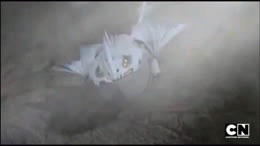ShinyHappyGoth
New Student
 Viking name: Valgerðr. Not exaclty the target demographic, but don't worry, I'm very immature.
Viking name: Valgerðr. Not exaclty the target demographic, but don't worry, I'm very immature.
Posts: 39 
|
Post by ShinyHappyGoth on Jul 26, 2013 0:07:32 GMT -8
I suppose this falls under fan fiction, since it's "scientific" speculation about freakin' dragons. Fan writing, certainly.
It is known from the movie that dragons are not internally fireproof, and that your basic firebreather actually produces a flammable gas and lights it on the way out (or, in the case of the Zippleback, when it's already out). You can actually see the gas building up in Toothless' throat at one point. According to Riders, the Monstrous Nightmare uses flammable saliva instead, but the principle is the same. So we know that your typical dragon has (a) an internal chemical factory and (b) a lighter of some kind in its mouth/throat.
Book of Dragons claims that the Scauldron stores boiling water in its stomach, but that strikes me as a contradiction. I can understand why Bork might assume that, and it's not like he'd have gotten a chance to examine the mechanism, but it would require significant internal heat-resistance, which contradicts Hiccup's findings, and the Scauldron would have to keep the water hot the whole time, which is not at all energy-efficient. Instead, I'd imagine it works rather like my office's water dispenser, which keeps all the water in the same tank but, when you use the hot tap, passes it over a heating element which heats it very quickly as it dispenses. In other words, the water isn't hot at all until it's in the process of leaving the dragon.
The same goes for the Gronckle. Storing magma in one's belly seems far less likely than storing fine-ground rocks in one's belly and melting them as they're expelled.
The Changewing is an interesting one, with its acid. I see two possibilities. One, that's stomach acid and it's basically vomiting at you. Simple, but less fun than my other idea, plus if it got in a fight right after lunch it'd be vomiting up its food as well and have to eat again, plus if it needed to store enough extra-strength gastric acid for use as ammo, it'd be seriously prone to ulcers. Therefore, I propose Option #2: Instead of the usual flammable gas, it produces at least two different chemicals and stores them separately. (One of the chemicals might be the usual gas, I dunno.) Then it expels them together, and they combine while passing the dragon's heating element, activating a chemical reaction and producing the acid in mid-spit.
I like to keep my disbelief suspended at a consistent height. ;-)
|
|
|
|
Post by Skips on Jul 26, 2013 4:23:47 GMT -8
Excellent musings, makes for a very interesting read.
Thanks for sharing~!
(Unfortunately I cannot science so I have nothing to add)
|
|
|
|
Post by oldrockgod on Aug 9, 2013 5:28:53 GMT -8
In the books when Hiccup is swallowed by a sea Giganticus Maximus, he hangs just inside it's mouth and inside the throat are two holes at either end that the fire is supposedly produced from which would be the lighter. Now In the books he defeats the sea Giganticus Maximus be blocking these holes up which causes the dragons to blow up a lot like in the movie when it crashes into the floor. This creates the presumption that the lighter in the throat is reliant on some sort of pressure to force it out so is the gas it's self the propellant or is it the lighter? however that could very from dragon to dragon.
for example the gronkle doesn't spit the rocks out per-say but keeps it in it's mouth then fills it's mouth with the gas and lights it just before opening the mouth expelling the flaming hot molten rocks.
|
|
ShinyHappyGoth
New Student
 Viking name: Valgerðr. Not exaclty the target demographic, but don't worry, I'm very immature.
Viking name: Valgerðr. Not exaclty the target demographic, but don't worry, I'm very immature.
Posts: 39 
|
Post by ShinyHappyGoth on Aug 9, 2013 6:52:19 GMT -8
In the books when Hiccup is swallowed by a sea Giganticus Maximus, he hangs just inside it's mouth and inside the throat are two holes at either end that the fire is supposedly produced from which would be the lighter. Now In the books he defeats the sea Giganticus Maximus be blocking these holes up which causes the dragons to blow up a lot like in the movie when it crashes into the floor. This creates the presumption that the lighter in the throat is reliant on some sort of pressure to force it out so is the gas it's self the propellant or is it the lighter? however that could very from dragon to dragon. for example the gronkle doesn't spit the rocks out per-say but keeps it in it's mouth then fills it's mouth with the gas and lights it just before opening the mouth expelling the flaming hot molten rocks. Well, I'm not factoring the books into my current analysis. They're very different canons, and while the movie dragons might have throat-holes either for the gas or the lighter, there's no evidence to indicate that either way. Conversely, while the books are very strong on detailing dragons' stats and abilities, they give less material from which to draw logical conclusions. I try not to assume any overlap until it's shown. What you say about the Gronckle utilizing the gas-fire to melt the rocks makes sense, though. Silly me, I'd just been thinking in terms of a ridiculously hot heating element, but that would probably be far more effective. And tough as the Gronckle is, it might actually be able to tolerate the internal heat for the brief periods necessary, so melting could happen in the gizzard or what have you prior to expulsion. (We do see an internal glow from the-Gronckle-later-to-be-known-as-Meatlug when she's about to blast Hiccup, unlike the other dragons where we just see gas buildup.) |
|
|
|
Post by dragonmaster on Aug 10, 2013 13:01:48 GMT -8
I suppose this falls under fan fiction, since it's "scientific" speculation about freakin' dragons. Fan writing, certainly. It is known from the movie that dragons are not internally fireproof, and that your basic firebreather actually produces a flammable gas and lights it on the way out (or, in the case of the Zippleback, when it's already out). You can actually see the gas building up in Toothless' throat at one point. According to Riders, the Monstrous Nightmare uses flammable saliva instead, but the principle is the same. So we know that your typical dragon has (a) an internal chemical factory and (b) a lighter of some kind in its mouth/throat. Book of Dragons claims that the Scauldron stores boiling water in its stomach, but that strikes me as a contradiction. I can understand why Bork might assume that, and it's not like he'd have gotten a chance to examine the mechanism, but it would require significant internal heat-resistance, which contradicts Hiccup's findings, and the Scauldron would have to keep the water hot the whole time, which is not at all energy-efficient. Instead, I'd imagine it works rather like my office's water dispenser, which keeps all the water in the same tank but, when you use the hot tap, passes it over a heating element which heats it very quickly as it dispenses. In other words, the water isn't hot at all until it's in the process of leaving the dragon. The same goes for the Gronckle. Storing magma in one's belly seems far less likely than storing fine-ground rocks in one's belly and melting them as they're expelled. The Changewing is an interesting one, with its acid. I see two possibilities. One, that's stomach acid and it's basically vomiting at you. Simple, but less fun than my other idea, plus if it got in a fight right after lunch it'd be vomiting up its food as well and have to eat again, plus if it needed to store enough extra-strength gastric acid for use as ammo, it'd be seriously prone to ulcers. Therefore, I propose Option #2: Instead of the usual flammable gas, it produces at least two different chemicals and stores them separately. (One of the chemicals might be the usual gas, I dunno.) Then it expels them together, and they combine while passing the dragon's heating element, activating a chemical reaction and producing the acid in mid-spit. I like to keep my disbelief suspended at a consistent height. ;-) Well in the season finale, it TRIES to spit out water but instead only spits out some gas. Savage also says it only gets enough water to keep it alive. So I would have to agree with bork on the fact that it stores its water in its stomach and keeps it hot. If it did not keep it hot the whole time, a gas that was not visible would have been expelled. Water vapour (in gas form after its hot) is visible. Other gas is not. Enough water to keep it alive would mean it didn't get any water to use as ammo. So the gas got expelled instead of water. |
|
ShinyHappyGoth
New Student
 Viking name: Valgerðr. Not exaclty the target demographic, but don't worry, I'm very immature.
Viking name: Valgerðr. Not exaclty the target demographic, but don't worry, I'm very immature.
Posts: 39 
|
Post by ShinyHappyGoth on Aug 10, 2013 13:14:41 GMT -8
I suppose this falls under fan fiction, since it's "scientific" speculation about freakin' dragons. Fan writing, certainly. It is known from the movie that dragons are not internally fireproof, and that your basic firebreather actually produces a flammable gas and lights it on the way out (or, in the case of the Zippleback, when it's already out). You can actually see the gas building up in Toothless' throat at one point. According to Riders, the Monstrous Nightmare uses flammable saliva instead, but the principle is the same. So we know that your typical dragon has (a) an internal chemical factory and (b) a lighter of some kind in its mouth/throat. Book of Dragons claims that the Scauldron stores boiling water in its stomach, but that strikes me as a contradiction. I can understand why Bork might assume that, and it's not like he'd have gotten a chance to examine the mechanism, but it would require significant internal heat-resistance, which contradicts Hiccup's findings, and the Scauldron would have to keep the water hot the whole time, which is not at all energy-efficient. Instead, I'd imagine it works rather like my office's water dispenser, which keeps all the water in the same tank but, when you use the hot tap, passes it over a heating element which heats it very quickly as it dispenses. In other words, the water isn't hot at all until it's in the process of leaving the dragon. The same goes for the Gronckle. Storing magma in one's belly seems far less likely than storing fine-ground rocks in one's belly and melting them as they're expelled. The Changewing is an interesting one, with its acid. I see two possibilities. One, that's stomach acid and it's basically vomiting at you. Simple, but less fun than my other idea, plus if it got in a fight right after lunch it'd be vomiting up its food as well and have to eat again, plus if it needed to store enough extra-strength gastric acid for use as ammo, it'd be seriously prone to ulcers. Therefore, I propose Option #2: Instead of the usual flammable gas, it produces at least two different chemicals and stores them separately. (One of the chemicals might be the usual gas, I dunno.) Then it expels them together, and they combine while passing the dragon's heating element, activating a chemical reaction and producing the acid in mid-spit. I like to keep my disbelief suspended at a consistent height. ;-) Well in the season finale, it TRIES to spit out water but instead only spits out some gas. Savage also says it only gets enough water to keep it alive. So I would have to agree with bork on the fact that it stores its water in its stomach and keeps it hot. If it did not keep it hot the whole time, a gas that was not visible would have been expelled. Water vapour (in gas form after its hot) is visible. Other gas is not. Enough water to keep it alive would mean it didn't get any water to use as ammo. So the gas got expelled instead of water. Not every non-water gas is invisible (the flammable gas most dragons use is green), and there is water vapour in the air at all times which is not visible. Anyway, it seems to me that what they were going for in that scene was that the Scauldron was trying to blast them, but it could barely spare any water for the purpose, so little that it instantly vapourized into the steam we saw. That actually seems to me to support my hypothesis; if it kept the water hot inside, it would probably keep it at a constant temperature, likely just below boiling, so it would still come out as a scalding liquid, albeit a very small quantity. Instead, it's trying to heat it up on the spot using the same amount of heat it would normally use for a larger quantity, with a similar result to what happens if you splash a few drops of water on a hot stove rather than heating an entire kettle. |
|






